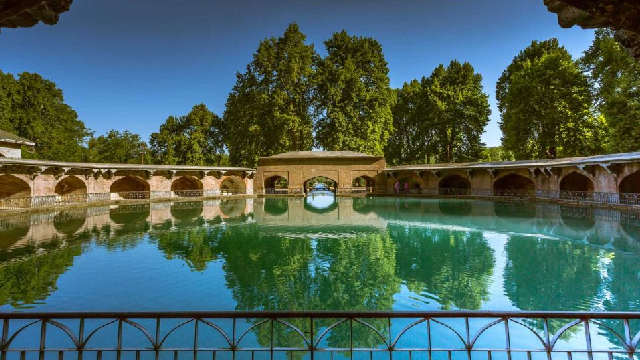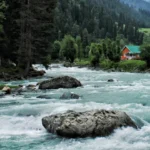Table of Contents
Toggle- Overview
- Verinag Spring
- Geological Significance of Verinag Spring
- Verinag: History and the past
- Stunning Mughal Garden in Verinag
- Conservation and Preservation
- Spiritual and Cultural Significance of Verinag Spring
- Best Time to Visit Verinag
- How to Reach Verinag Spring
- Conclusion
- How to book Verinag tour online?
- People Also Ask
- What is Verinag Spring?
- Where is Verinag Spring located?
- What makes Verinag Spring famous?
- How can I reach Verinag Spring?
- What is the best time to visit Verinag Spring?
- Is there a Mughal garden at Verinag Spring?
- What are the main attractions of Verinag Spring?
- Is Verinag Spring a religious site?
- Can I visit Verinag Spring year-round?
- What is the significance of Verinag Spring for the Jhelum River?
- Is Verinag Spring good for photography?
- Can I picnic near Verinag Spring?
- Are there any nearby attractions to Verinag Spring?
- What is the history of Verinag Spring?
- Are there any accommodation options near Verinag Spring?
- Can I swim in Verinag Spring?
- Is there a local market near Verinag Spring?
- What type of wildlife can I find near Verinag Spring?
- Can I visit Verinag Spring as a day trip from Srinagar?
- Is there an entry fee to visit Verinag Spring?
- What are the nearby temples to Verinag Spring?
- Is Verinag Spring accessible for disabled tourists?
- Is there a guide available at Verinag Spring?
- What is the architectural style of the Mughal garden at Verinag Spring?
- What should I carry when visiting Verinag Spring?
- Inquiry Form
Overview
Verinag Spring and the accompanying Mughal Garden hold a treasure, both historically as well as geographical and cultural terms of importance within the region. The sites such as these continue to attract tourists worldwide, in particular at those with historical backgrounds and marvelous architecture with wealth of natural beauty. As you walk through the lush gardens and glance upon the glistening waters of the Verinag Spring, you may easily see why this place has been considered to be one of Kashmir’s most captivating getaways.
In this detailed and lengthy blog, we will delve into the Verinag Spring, its origin, the Mughal garden that has been constructed around it, and all the history behind it. We’ll cover its ecological importance and the experience of visiting this beautiful landmark. By the time you finish reading this post, you will have had all the details on why Verinag is important, not just as a tourist destination but also a hub replete with culture and history.
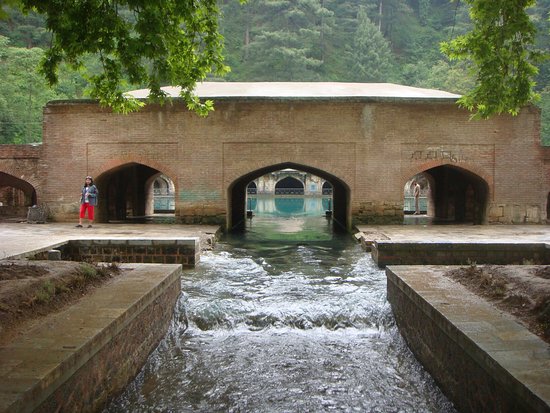
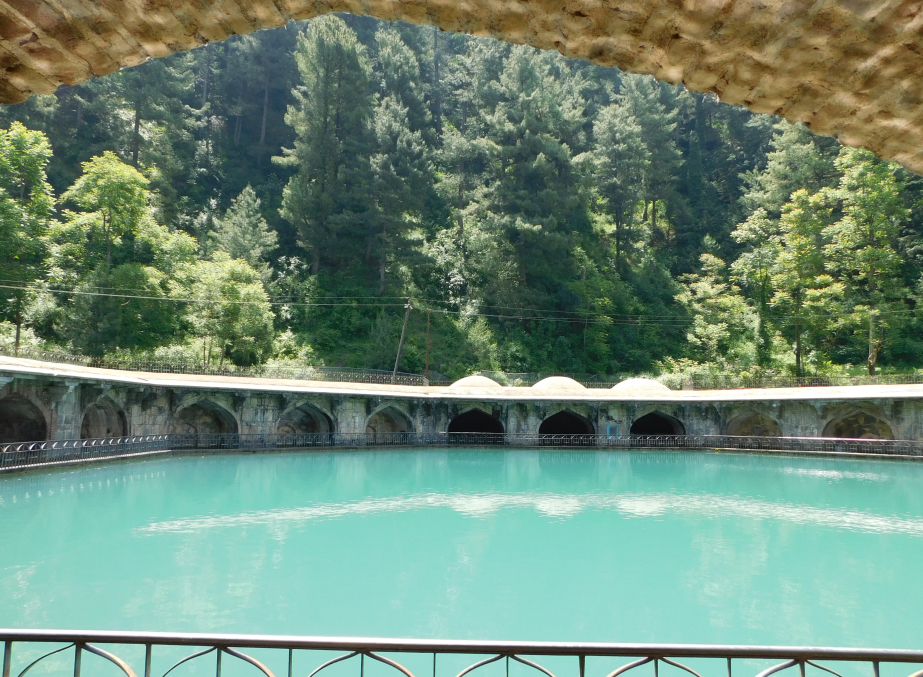
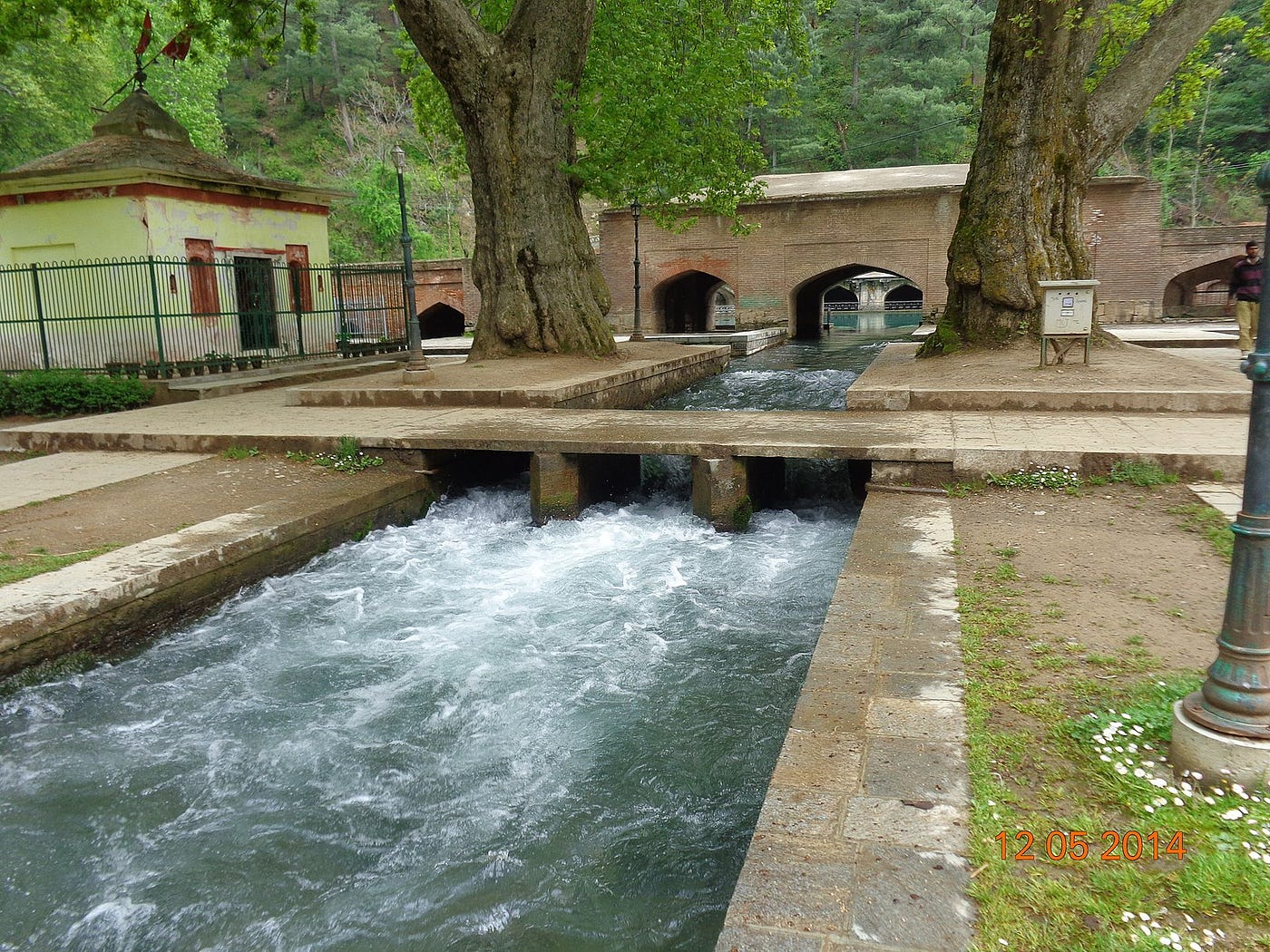
Verinag Spring
Verinag Spring is one of the largest and most important freshwater springs in the area, located in the Anantnag district of Jammu and Kashmir. It supplies the main water source of the Jhelum River, which for centuries has been the lifeblood of Kashmir’s agricultural economy. The geology of the spring, against the breathtaking backdrop, has made it one of the most beautiful places in the Kashmir Valley.
It is named after a serpent deity in local Kashmiri mythology. The word “Verinag” is derived from two Sanskrit words: “Vera” meaning serpent and “Nag” meaning spring. According to local legend, a large serpent dwelled in the area, and it was this serpent that caused the spring to emerge in this particular region. This mystical association with a snake is but one of the reasons the spring is a sanctum in the hearts of natives.
The water from the spring is so pure and crystal that it flows freely through an open hole in rocks. The non-stop flow also has a scientific aspect. It’s environmentally important as it irrigates farms and provides townships nearby with water supply.
Geological Significance of Verinag Spring
An Exclusive Source of Water
The water is flown from the adjacent mountains underground before coming out with a small orifice opening within the rock mass. It is an outstanding example of karst spring in geological terms, and due to its purity and clarity, the water makes for a wonder. Scientists and tourists come and study this stream, as there is always regular flow in water that supports and maintains the inflow in Jhelum River the whole year.
Spring water is almost always cold; in the summer months, when the sun manages to warm up the whole region, it remains within a narrow margin. This constancy of temperature and flow makes Verinag an important source of water for the region.
Function of Verinag Spring in Regional Ecology
This spring is highly ecologically important. It is the origin of one of the significant watercourses that flow into the Kashmir Valley; the Jhelum River and is an essential source of water for drinking as well as agriculture. The river also supports numerous ecosystems. The lush vegetation around Verinag Spring, comprising fruit orchards and farmlands, is sustained by the water of the spring, which irrigates the fields and brings life-giving moisture to the region.
It also houses a great fauna of diverse avifauna, insectivora, and aquatica surviving on water of the spring. The surrounding forests and grasslands are lush green and well-maintained due to permanent flow of water and teeming with flora and fauna that add a new dimension of ecological attraction to the landscape.
Verinag: History and the past
This water spring of Verinag has its origin deep in the myth and legend of Kashmir. It is argued that the water was the result of a great serpent (Vera), who had divine power which caused water to emanate from this place and flow that way. This mystique has made it a place revered since ages.
The area surrounding Verinag has been inhabited since time immemorial. Archaeological research indicates that Kashmir Valley was inhabited as early as the prehistoric period. Many of the early Hindu and Buddhist settlements were in the valley. In fact, the Verinag Spring is referred to as an important divine site in some of the ancient texts.
Mughal Legacy: The Verinag Garden
The Mughal dynasty is particularly known for architectural brilliance and landscaping. During the 16th century, this empire significantly contributed to the development of the Verinag Spring. In his reign, Emperor Jahangir transformed the spring and its surroundings into an outstanding Mughal Garden. This is an example of the elegance and splendor that Mughal garden designs represent, highly influenced by Persian architecture and the Islamic theory of landscaping.
The site was allegedly visited by Jahangir who was attracted by the beauty of nature around and at the spring and, impressed, he turned it into a formal garden adding ornamentations with all the characteristics typical of the Mughal garden design. He made use of symmetry, water flows, and ornate fountains typical for Mughal gardens and which represented an embodiment of the ideal Mughal concept of paradise on earth.
The Mughal Garden Design: Chahar Bagh
This Mughal design can be considered as Chahar Bagh or a fourfold garden at Verinag garden. Verinag Spring has been a focal water point with channels coming out from the four cardinal points; it also cuts the whole area of the garden into equal halves along these cardinal lines in both directions. A perfectly symmetrical plan would depict the four rivers that have appeared in texts, said to represent heaven in the Quran and Hadith.
The Chahar Bagh concept essentially translates to be an ideal equilibrium of water, plants, and buildings, that is, the natural beauty synchronised with structures developed by mankind. The four sections of the garden were planted with foliage, blooming flowers and fruits trees from the very outset and the atmosphere transformed into a very tranquil and placid one.
Stunning Mughal Garden in Verinag
This is a great architectural marvel erected to depict the look of heaven. The garden is quite expansive and divided into four quadrants that represent four seasons with plenty of plant species. Some of the attractive features include the following:
1. Symmetry and Water Flow: The garden is built with absolute symmetry in mind. The central water channel that begins from the Verinag Spring forms the spine of the garden, with smaller channels and fountains branching off. The soothing sound of flowing water creates an atmosphere that enhances the experience of the garden.
2. The Marble Basin: In the center of the garden, is the marble basin where the Verinag Spring sits. Water flows out in one continuous flow which is channelled into several fountains and pools. Elaborate carvings surround the marble basin; these exemplify the master workmanship of the Mughal craftsmen.
3. Floral Diversity: The Mughal love for flower diversity has really been done great justice with its garden that provides a range of flowers and herbs, including roses, lilies, jasmine, and poppies, which are more than beautiful with their fragrance-rich beauty filling up the air heavy with it that is indeed great sensory delight to every visitor.
4. Ornamental Fountains and Pools: Ornamental fountains and pools are the hallmark of Mughal garden design. Water flows through the intricate system of channels, cascading into pools and smaller fountains. These water features are designed to reflect light and create a tranquil environment.
5. Pavilions and architecture: Along with landscapes, there also are other things, that make a part of the Mughal garden like architectures. As a case at Verinag, there have pavilions, arches and structures even marble scattering on the entire terrain. This will help these architecture pieces allow others to surrender, hence blend together, as formed by nature to beautify them while provide the secluded shadow for one resting there. 10.
Conservation and Preservation
With time, the garden at Verinag, like most other historical places, has faced destruction from natural calamities and ravages of time. Efforts have been made in the last few years to restore it to its original beauty. The restoration work involves fixing the broken structures, preserving the fountains, and making sure the water channels remain open.
Attempts have also been made to increase biodiversity in the garden, as frequent planting of indigenous species helps in keeping the flora alive and lively. The Mughal craftsmanship in the form of architecture is strictly preserved; for this, it has to be restored with expert hands by adopting traditional methods.
Spiritual and Cultural Significance of Verinag Spring
A Holy Abode for the Locals
The water of the Verinag Spring is spiritually very important to the people of Kashmir. It is a sacred site where people believe that the water of the spring can heal diseases and ailing people. Local Kashmiri people visit the site to offer their prayers, seek blessings, and revel in the beauty of nature surrounding the spring. This site is very sacred for Hindus; most religious rituals are performed near the site.
The mystique of the spring is enhanced by the association with the divine serpent. Tourists normally stop and reflect in silence, admiring the serenity of the surroundings and the peacefulness that pervades the atmosphere.
A Cultural Icon of Kashmir
In other words, it depicts the richness of the culture that Kashmir possesses. Needless to say, the impact of Mughal influence upon art, architecture, and gardening has left a landmark mark on Verinag as it is still considered one of the legacy inheritances in the region of Kashmir. Gradually, through these years, the garden and spring depict this intermingling of Hindu-Buddhist traditions in Kashmir along with the culture.
Mughal Garden of Verinag still continues to attract importance in Kashmir’s cultural heritage for its nature but also to draw visitors there with historical significance.
Best Time to Visit Verinag
The best time to visit Verinag Spring and Mughal Garden is in spring and summer from April to October. It provides the most agreeable weather in which temperatures may vary between 15°C to 30°C. Thus, this is an excellent time for visitors to visit the garden as its beauty comes alive. Flowers add another flavor and color during this season that gives an immense feel of a sweet experience in the garden.
If you prefer smaller crowds, it is possible to visit during the shoulder seasons, either in early spring or late summer.
How to Reach Verinag Spring
Verinag is about 25 km from Anantnag and can be reached by road from Srinagar. Taxi and bus facilities are available from Srinagar to reach Verinag. The nearest airport is Sheikh ul-Alam International Airport, Srinagar. This is one of the prominent airports well connected to all other important cities of India.
Conclusion
In themselves, Verinag Spring and the Mughal Garden are very beautiful tourist attractions, but as being a living piece of history, culture, and nature, in this way, they have in the waters of this serene spring been complemented great by the richness of the Mughal garden. It is set so peacefully and in an awesome manner that be you a genre-in whatever fall-do you-the nature lover, the history enthusiast, or just a spiritual retreat: Verinag has got something for everyone.
This age-old gem of Kashmir heritage remains a fascinating wonder for tourists who visit, in its old stories, breathtaking beauty, and quiet environs. If you are ever visiting Kashmir, don’t miss this golden opportunity to see the Mughal Garden with Verinag Spring, which is perhaps the most beautiful and historic place in the valley.
How to book Verinag tour online?
Contact Brown Chinar at +91 6005039532/+91 9906188874 or Email us at : Enquiry@brownchinarkashmir.com
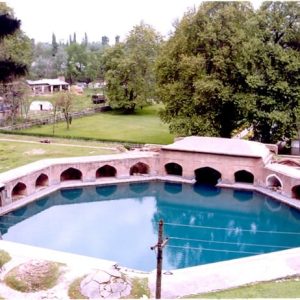
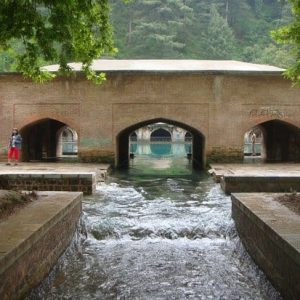
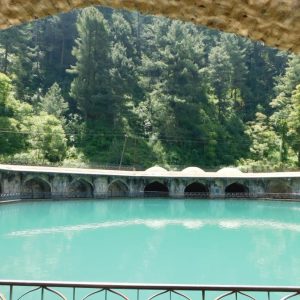
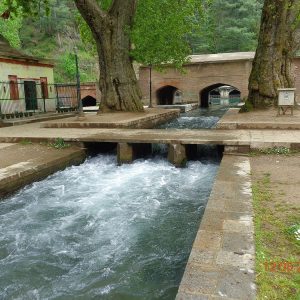
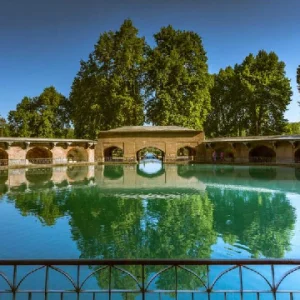
People Also Ask
What is Verinag Spring?
Verinag Spring is a natural freshwater spring located in the Anantnag district of Jammu and Kashmir, India. It is known for its crystal-clear water that forms a large, round-shaped pool. The spring is the source of the River Jhelum and is surrounded by picturesque landscapes and lush greenery.
Where is Verinag Spring located?
Verinag Spring is located approximately 80 kilometers southeast of Srinagar, the summer capital of Jammu and Kashmir. It lies near the town of Anantnag and is easily accessible by road from Srinagar.
What makes Verinag Spring famous?
Verinag Spring is famous for its pristine and clear blue water that emerges from the foothills of the Pir Panjal mountain range. It is the main source of the River Jhelum and is also a significant site for its historical and religious importance. The surrounding Mughal garden adds to its allure.
How can I reach Verinag Spring?
Verinag Spring is accessible by road from Srinagar, which is about 80 kilometers away. You can hire a taxi or take a local bus to reach the spring. The nearest airport is in Srinagar, and the nearest railway station is in Anantnag.
What is the best time to visit Verinag Spring?
The best time to visit Verinag Spring is during the spring and summer months (March to June) when the weather is pleasant. The spring is also quite scenic during the autumn months (September to November). Winter months (December to February) can be cold, but snow adds to the beauty of the area.
Is there a Mughal garden at Verinag Spring?
Yes, there is a Mughal garden surrounding Verinag Spring. The garden was built during the Mughal era and is designed in a traditional Persian style. The layout includes terraced gardens, pathways, fountains, and water channels that enhance the natural beauty of the spring.
What are the main attractions of Verinag Spring?
The main attractions of Verinag Spring include the clear blue spring water, the Mughal garden, the surrounding mountains, and the nearby temples. The spring itself is a major tourist destination, and the garden offers a peaceful place for visitors to relax and enjoy nature.
Is Verinag Spring a religious site?
Yes, Verinag Spring is considered a sacred site. According to local legends, it is believed to have religious significance. It is also associated with the story of the sage Vishnu, and the nearby temple dedicated to Lord Vishnu attracts pilgrims.
Can I visit Verinag Spring year-round?
Yes, Verinag Spring is open to visitors throughout the year. However, during the winter months, heavy snowfall can make travel to the site more challenging. It is advisable to check weather conditions before planning a trip in winter.
What is the significance of Verinag Spring for the Jhelum River?
Verinag Spring is the primary source of the River Jhelum, which flows through Kashmir and holds significant cultural and historical importance in the region. The spring’s water feeds into the Jhelum River, which plays an essential role in the region’s agriculture and daily life.
Is Verinag Spring good for photography?
Yes, Verinag Spring is an excellent destination for photography. The lush greenery, serene water, historic Mughal garden, and surrounding mountains provide an ideal backdrop for both landscape and nature photography.
Can I picnic near Verinag Spring?
Yes, Verinag Spring is a peaceful place ideal for a picnic. The Mughal garden surrounding the spring offers well-maintained paths and areas for sitting, making it a great spot for a relaxing family outing or a picnic in nature.
Are there any nearby attractions to Verinag Spring?
Nearby attractions include:
- Anantnag: Known for its temples and vibrant markets.
- Kokernag: Famous for its beautiful spring and lush greenery.
- Pahalgam: A picturesque town popular for trekking and scenic views.
- Sheshnag Lake: A sacred high-altitude lake located nearby.
What is the history of Verinag Spring?
Verinag Spring dates back to the Mughal period, with Emperor Jahangir commissioning the construction of the Mughal garden around the spring. The site holds historical significance, with the garden being a reflection of Mughal architectural style and Persian landscaping.
Are there any accommodation options near Verinag Spring?
While there are no accommodations directly at Verinag Spring, nearby towns like Anantnag, Srinagar, and Pahalgam offer a range of accommodation options, from guesthouses to luxury hotels. Staying in these towns provides easy access to the spring and nearby attractions.
Can I swim in Verinag Spring?
No, swimming in Verinag Spring is not permitted due to the religious and ecological importance of the site. Visitors are encouraged to enjoy the spring’s natural beauty from the surrounding areas and gardens.
Is there a local market near Verinag Spring?
While there is no major market directly at Verinag Spring, the nearby town of Anantnag has local markets where visitors can buy souvenirs, local handicrafts, and Kashmiri goods such as woolen shawls, saffron, and dry fruits.
What type of wildlife can I find near Verinag Spring?
The area surrounding Verinag Spring is rich in flora and fauna. Visitors may encounter various species of birds, including Himalayan pheasants and migratory birds. The nearby forests are home to wildlife such as deer, monkeys, and other small mammals.
Can I visit Verinag Spring as a day trip from Srinagar?
Yes, Verinag Spring is about 80 kilometers from Srinagar and can easily be visited as a day trip. The drive takes around 2 to 3 hours, making it a convenient option for a short excursion from Srinagar.
Is there an entry fee to visit Verinag Spring?
No, there is no entry fee to visit Verinag Spring. However, visitors may need to pay for transportation or a guide if they choose to hire one for the trip. Costs for activities such as photography permits may vary.
What are the nearby temples to Verinag Spring?
The nearby Verinag Temple, dedicated to Lord Vishnu, is a prominent religious site for Hindus. It is located close to the spring and is an important pilgrimage site in the region.
Is Verinag Spring accessible for disabled tourists?
While Verinag Spring and the surrounding Mughal garden are generally accessible, some areas may have uneven terrain, which could pose difficulties for tourists with mobility challenges. It’s advisable to check the specific accessibility conditions before visiting.
Is there a guide available at Verinag Spring?
Yes, local guides can be hired near Verinag Spring or in nearby towns like Anantnag. These guides can provide historical insights, local legends, and detailed information about the spring and the Mughal garden.
What is the architectural style of the Mughal garden at Verinag Spring?
The Mughal garden at Verinag Spring follows the traditional Persian garden design, featuring terraced levels, water channels, and fountains. The garden is divided into four sections, with lush greenery, flowers, and geometric layouts typical of Mughal-era architecture.
What should I carry when visiting Verinag Spring?
When visiting Verinag Spring, you should carry:
- Comfortable walking shoes
- A camera for photography
- Sun protection (hat, sunglasses, sunscreen)
- Water and snacks
- A light jacket (for cooler months)
- Any necessary personal medications

